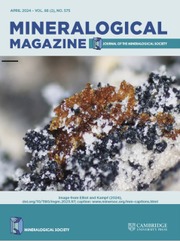Article contents
Extending the mineralogy of U6+ (I): Crystal structure of lepersonnite-(Gd) and a description of the new mineral lepersonnite-(Nd)
Published online by Cambridge University Press: 14 July 2025
Abstract
Two uranyl carbonate silicate minerals have been studied in detail, lepersonnite-(Gd) and the new mineral lepersonnite-(Nd). Both minerals originate from Katanga province in the Democratic Republic of Congo (Africa): lepersonnite-(Gd) from the Shinkolobwe mine (type locality) and lepersonnite-(Nd) from the Swambo mine (type locality) and Shinkolobwe mine. Each occurs as radial to acicular aggregates composed of long prismatic, thin crystals, as the products of hydration–oxidation weathering of uraninite. A detailed description of the chemical and physical properties of lepersonnite-(Nd) is provided, including the thermal analysis of the -(Gd) member. Moreover, Raman and infrared spectroscopy data are provided for both minerals. The crystal structure of lepersonnite-(Gd) has been solved based on 3D electron diffraction data. According to the best dataset at 95 K, lepersonnite-(Gd) is orthorhombic, with a = 11.838(134) Å, b = 15.822(333) Å, c = 39.147(190) Å and V = 7353(282) Å3 (Z = 4). The dynamic refinement of the crystal structure (Robs/wRobs = 0.1204/0.1088 and Rall/wRall = 0.1204/0.1088 for 3090/50507 observed/all reflections and 247 refined parameters) revealed a large complex sheet structure with structural units defining a new lepersonnite topology. It contains infinite sheets of uranyl polyhedra, planar CO3 groups, protonated Si-tetrahedra, and Gd3+ polyhedra, and a thick interlayer hosted with H2O and partially occupied Ca2+ sites. Based on the structure refinement, bond-valence considerations, and new electron microprobe data, we infer that the ideal formula of lepersonnite-(Gd) is [Ca0.5Gd0.5(H2O)18(OH)1.5] [Gd(UO2)12(SiO3OH)2(CO3)4(OH)10O2(H2O)5]. On the basis of their closely related powder X-ray diffraction patterns and the similar behaviour of Nd and Gd, we expect the two minerals to adopt the same structures, apart from Ca, which was absent in lepersonnite-(Nd). The ideal formula for lepersonnite-(Nd) is [Nd(H2O)18(OH)2][Nd(UO2)12(SiO3OH)2(CO3)4(OH)10O2(H2O)5].
Keywords
Information
- Type
- Article
- Information
- Copyright
- © The Author(s), 2025. Published by Cambridge University Press on behalf of The Mineralogical Society of the United Kingdom and Ireland.
Footnotes
Associate Editor: Oleg I Siidra
We dedicate this paper to Michel Deliens, our dear friend and colleague, on the occasion of his 85th birthday.
References
- 2
- Cited by

